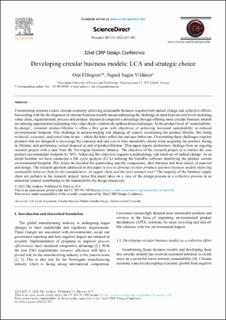| dc.contributor.author | Ellingsen, Oda | |
| dc.contributor.author | Vildåsen, Sigurd | |
| dc.date.accessioned | 2023-01-01T11:56:11Z | |
| dc.date.available | 2023-01-01T11:56:11Z | |
| dc.date.created | 2022-06-30T12:01:27Z | |
| dc.date.issued | 2022 | |
| dc.identifier.citation | Procedia CIRP. 2022, 109 437-442. | en_US |
| dc.identifier.issn | 2212-8271 | |
| dc.identifier.uri | https://hdl.handle.net/11250/3040137 | |
| dc.description.abstract | Transitioning towards a more circular economy achieving sustainable business requires both radical change and collective efforts. Succeeding with the development of circular business models means addressing the challenge at hand from several levels including value chain, organizational, process and product. Increased competitive advantage through offering more circular business models are enticing opportunities explaining why value chains collectively address these challenges. At the product level of ‘sustainability-by-design’, extended product-lifetime is often a first go-to with objectives of achieving increased sustainability or reduced environmental footprint. One challenge is acknowledging and aligning all aspects constituting the product lifetime, this being technical, economic, and actual time in use - where the latter reflect the end user behaviors. Overcoming these challenges requires products that are designed to encourage the customer and end user to take sustainable choice when acquiring the product, during its lifetime, and performing correct disposal at end of product lifetime. This paper reports preliminary findings from an ongoing research project with a case from the Norwegian furniture industry. The objective of the research project is to reduce the case product environmental footprint by 50%. Achieving this objective requires a methodology and mind-set of radical change. As an initial baseline we have conducted a life cycle analysis (LCA) utilizing the SimaPro software identifying the product current environmental footprint. This forms the baseline for questioning specific components, their function and their choice of material and design. The research question addressed in this paper is how to develop circular products and new business models enforcing sustainable behavior both for the manufacturer, its supply chain and the end customer/user? The majority of the furniture supply chain are partners in the research project; hence this paper takes on a view of the design process as a collective process in an industrial context contributing to the sustainability-by-design discussion. | en_US |
| dc.description.abstract | Developing circular business models: LCA and strategic choice | en_US |
| dc.language.iso | eng | en_US |
| dc.publisher | Elsevier | en_US |
| dc.rights | Attribution-NonCommercial-NoDerivatives 4.0 Internasjonal | * |
| dc.rights.uri | http://creativecommons.org/licenses/by-nc-nd/4.0/deed.no | * |
| dc.title | Developing circular business models: LCA and strategic choice | en_US |
| dc.title.alternative | Developing circular business models: LCA and strategic choice | en_US |
| dc.type | Journal article | en_US |
| dc.type | Peer reviewed | en_US |
| dc.description.version | publishedVersion | en_US |
| dc.source.pagenumber | 437-442 | en_US |
| dc.source.volume | 109 | en_US |
| dc.source.journal | Procedia CIRP | en_US |
| dc.identifier.doi | 10.1016/j.procir.2022.05.275 | |
| dc.identifier.cristin | 2036302 | |
| dc.relation.project | Norges forskningsråd: 309920 | en_US |
| cristin.ispublished | true | |
| cristin.fulltext | original | |
| cristin.qualitycode | 1 | |

